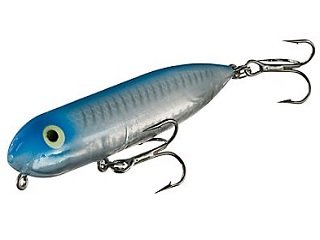 There are several techniques in fishing that are great at adding a little extra spark to a lure. These techniques also help entice fish just that much more, too. One such technique is walking the dog, which is a great topwater tactic. Here are a few walk-the-dog tips.
There are several techniques in fishing that are great at adding a little extra spark to a lure. These techniques also help entice fish just that much more, too. One such technique is walking the dog, which is a great topwater tactic. Here are a few walk-the-dog tips.
To start, you’ll want to make sure you choose the right lure, such as a Heddon Spook. For those of you unfamiliar with Spooks, they resemble tapered cigars with treble hooks. Heddon’s model is great and it’s been around for years, but now you can find great walk-the-dog lures from several companies. You’ll also want to choose a lure that’s heavy enough to cast long distances. The farther you can cast the lure, the less likely it will be that the fish will see you as they chase it back to the boat. I’d stick with lures in the 5/8 to 7/8-ounce range, especially for bass and inshore fishing.
I like to go with braided line when I’m using walk-the-dog lures, as do most anglers. The lack of stretch with braid means when you move your rod tip an inch, the lure moves an inch, which makes it possible to get some real “snap” in the action of your spook. Braid also makes hook sets much easier on long casts. To your braid, I’d also add around a foot to a foot and a half of 20-pound fluorocarbon leader, using a double Uni-knot to connect them.
Your rod action will also have a big impact on your walk-the-dog success. Soft action rods won’t do the job, so it’s best to go with a medium-heavy rod with a fast tip. Start with the rod tip a few inches off the water, then sharply twitch it a few inches, and then immediately drift the tip back toward the lure a few inches. This creates some slack in the line. Then, all you need to do is twitch and repeat, all the way back to the boat. Jerking against that bit of slack is super important at getting the zig-zag motion that makes up the essence of the walk-the-dog technique.
If you get a missed strike or a roll, don’t stop the retrieve; just keep walking the dog. Often times the fish will come back for a second strike. Although, it’s not a bad idea to have a spare combo on hand, rigged with a soft plastic swimbait, to cast to the spot where the fish blew up. Many anglers are surprised at how effective this simple switch can be.








